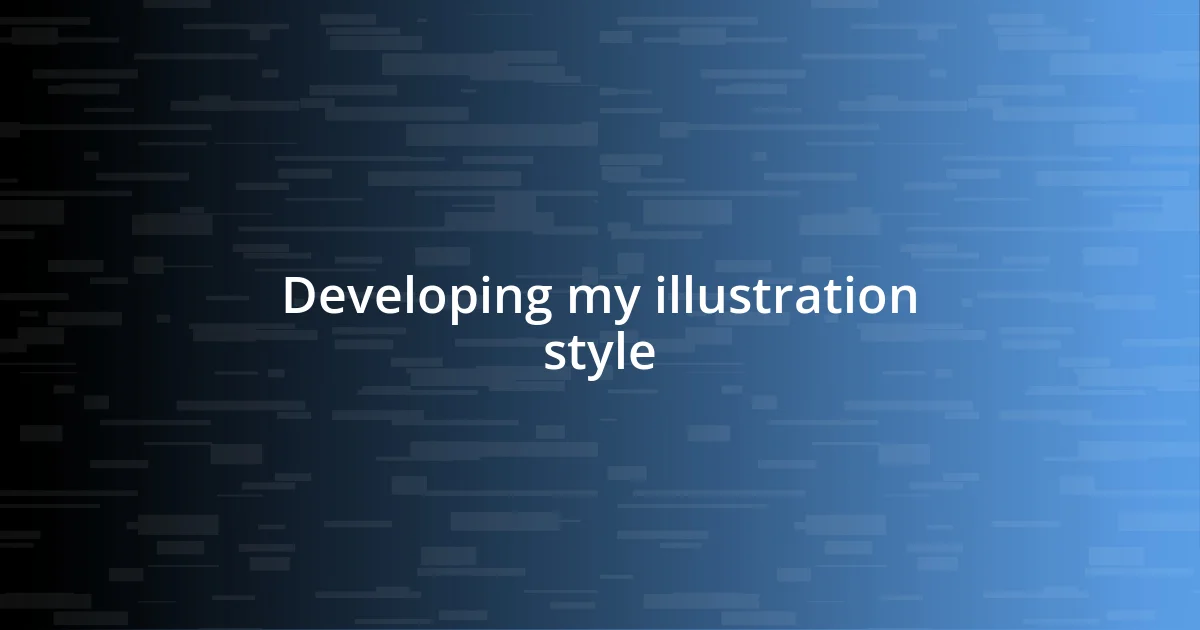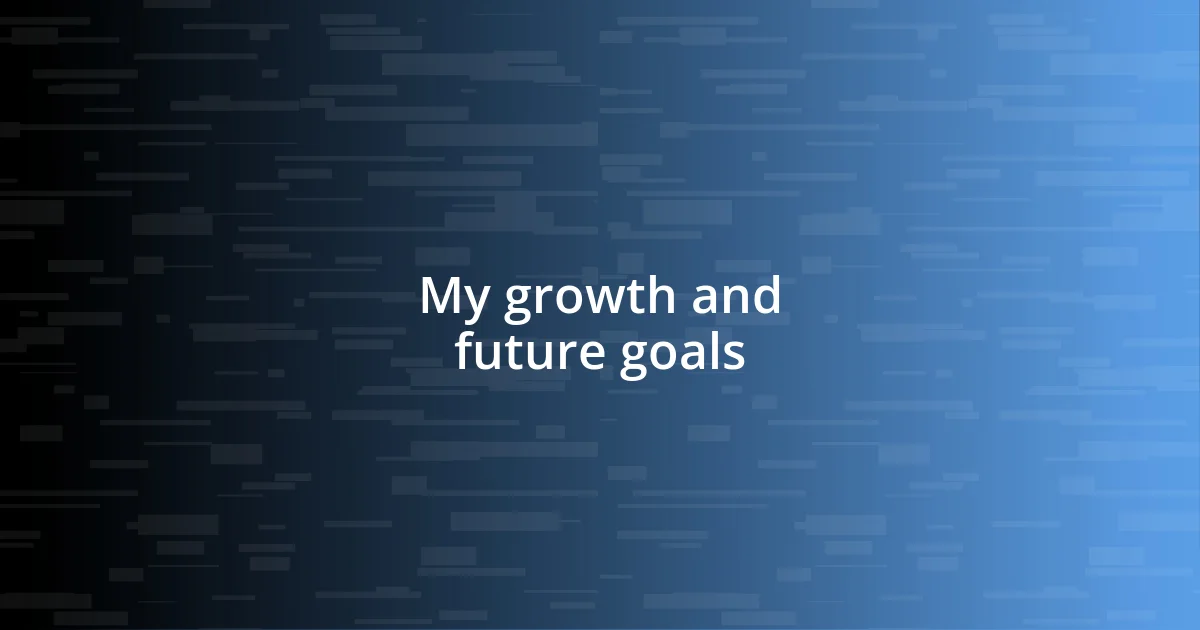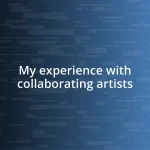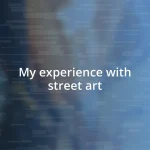Key takeaways:
- Initial excitement and exploration of digital illustration led to a transformative understanding of art beyond traditional mediums.
- Choice of tools like Adobe Photoshop and Procreate significantly influenced the creative process and style development.
- Building an online presence and engaging with the illustration community enhanced growth, collaboration, and the sharing of personal stories.

My introduction to digital illustration
I still remember the first time I opened a digital illustration program. The interface felt overwhelming yet exciting; it was like stepping into a vast, uncharted world of creativity. I recall fumbling with the tools, but I couldn’t shake the feeling that this was where I belonged, a place where my imagination could truly run wild.
As I picked up my tablet, a surge of nervous energy washed over me. Would I be able to translate my ideas onto the digital canvas? Each stroke felt like a conversation with myself, an exploration of shapes and colors that I had only dreamed of before. There’s something uniquely liberating about merging traditional art techniques with digital tools – it’s a dance between precision and intuition.
I often find myself reflecting on how digital illustration has transformed my understanding of art. Have you ever experienced that moment of pure flow, where time seems to stand still? For me, that happens when I create digitally. It’s a reminder that art isn’t confined to paper or canvas; it exists, pulsating with life, in the pixels and bytes of the digital world.

My tools and software choices
Choosing the right tools and software has been pivotal in my journey as a digital illustrator. Initially, I gravitated toward Adobe Photoshop, drawn in by its versatility. The array of brushes and capabilities allowed me to experiment with styles, and I often lost track of time just playing around with different textures. There’s a particular thrill in crafting intricate details or blending colors seamlessly, something that Photoshop truly excels at.
As I advanced, I discovered Procreate on my iPad, which opened up a different realm of creativity. I love the tactile feedback of drawing directly on the screen; it feels more like traditional drawing but with the added benefits of digital tools. I remember sketching outdoors one sunny afternoon, completely immersed in the moment, sketching my surroundings with ease. Procreate’s intuitive interface made it effortless to capture my ideas while they were fresh, which, as any illustrator knows, is crucial for creativity.
Each tool brings its own unique advantages and challenges, and I find myself often switching between them based on my mood or project requirements. For collaborative projects, I prefer using Adobe Illustrator because of its vector capabilities – scalability is crucial, especially when working on logos or web graphics. How about you? Have you thought about how your tools influence your creative process? It’s fascinating to reflect on how the right software can elevate our work to new heights.
| Tool/Software | Key Features |
|---|---|
| Adobe Photoshop | Versatile brushes, extensive editing capabilities |
| Procreate | Tactile interface, portability, user-friendly |
| Adobe Illustrator | Vector graphics, scalability, professional quality |

Developing my illustration style
Finding my illustration style has been both thrilling and challenging, almost like piecing together a jigsaw puzzle with each piece representing a different influence or technique. I remember sitting down late one night, headphones on and coffee in hand, surrounded by my previous sketches. It struck me how my early attempts were a chaotic mix of styles I admired. Yet, within that chaos, I began to notice glimmers of my unique voice emerging. It made me realize that developing a style isn’t about copying; it’s about synthesizing what resonates with me and putting my twist on it.
To hone my style, I focused on several key elements that shaped my approach:
- Experimentation: I embraced playing with colors and forms, allowing myself to break free from the constraints of perfection.
- Influence: I studied artists that inspired me, dissecting their techniques while consciously avoiding the trap of imitation.
- Reflection: Keeping a sketchbook for thoughts and ideas helped me understand my preferences and growth.
- Consistency: Regular practice allowed me to refine my style and grow more confident in my artistic choices.
- Feedback: I sought constructive criticism from fellow artists, which opened my eyes to aspects I hadn’t considered before.
Each of these elements played a crucial role in my journey to discover a style that truly felt like my own. Over time, I could feel the threads of my identity weaving into my work, creating a tapestry that is distinctly “me.”

Building my online presence
Building an online presence felt like stepping onto a stage for the first time—exciting but a bit daunting. I started by sharing my illustrations on social media platforms, and it was remarkable to see how this simple act opened up new connections. I vividly recall my first post; the rush of anticipation as I hit ‘share’ was a mix of hope and nervousness. It was thrilling to receive my first comments from people who appreciated my work, and that feedback fueled my desire to keep sharing.
As I dove deeper, I understood the importance of consistency in my online activity. Regularly posting not just illustrations but also behind-the-scenes looks at my creative process helped to build a community. For instance, I once shared a time-lapse video of an illustration coming to life, and the responses flooded in! People were eager to see how my ideas transformed into final pieces. Isn’t it fascinating how engaging your audience can change the dynamics of your artistic journey? It made me realize that my art wasn’t just about me anymore; it became part of a larger conversation.
Most importantly, I began to embrace the power of storytelling. Each piece of artwork I posted was accompanied by a narrative, whether it was the inspiration behind it or the challenges I faced while creating it. I discovered that people connect with stories far more than they do with images alone. One evening, after sharing a piece that resonated deeply with my personal experiences, I received a heartfelt message from a follower sharing how my journey inspired them. Moments like these reminded me that building an online presence isn’t just about showcasing talent; it’s about sharing your story and connecting with others on a meaningful level.

Engaging with the illustration community
Engaging with the illustration community has been one of the most enriching aspects of my artistic journey. I remember joining an online forum dedicated to digital art, feeling both excited and a little intimidated by the talent surrounding me. As I shared my work, I was met with encouraging responses. This sense of belonging ignited not just my passion for illustration but also my desire to contribute to others’ growth. Have you ever felt this surge of inspiration from those around you? It’s a powerful reminder of how community can elevate not just our skills but also our spirits.
Participating in local art meetups was another game changer. I vividly recall one evening spent sketching in a cozy café surrounded by fellow artists. The energy was infectious; we exchanged tips, critiqued each other’s work, and shared our individual journeys. I left that night with a renewed sense of purpose and a handful of new friends. How incredible is it that such simple gatherings can spark collaboration and creativity? The interaction with peers opened my eyes to new techniques and perspectives I hadn’t considered before.
Another impactful experience was joining collaborative projects and challenges. One year, I took part in an illustration challenge that required artists to create a piece every day for a month. It was both thrilling and exhausting! Each day brought unique themes and ideas, pushing me to explore styles I hadn’t tried before. Sometimes, I felt overwhelmed, but the supportive comments from fellow participants helped me push through. I can’t underscore enough how engaging with this community fostered my growth. Have you ever tried stepping out of your comfort zone? I found that by doing so, not only did I improve my skills, but I also strengthened my connections with other passionate illustrators.

My growth and future goals
As I reflect on my journey, I can see how far I’ve come as an illustrator. Initially, I struggled to find my unique style, often feeling like an imposter amongst more experienced artists. Then, one day while experimenting with colors, I created a piece that felt true to me. The rush of excitement after sharing it online was unlike anything I’d experienced before; it was as if I had finally found my voice. Isn’t it amazing how a single moment of inspiration can propel our growth forward?
Looking ahead, I’m eager to challenge myself even further by expanding my skills in animation. I can still remember my first attempt at animating one of my illustrations. The result was charmingly rough, but it ignited a spark within me. I envisioned creating stories that came to life, blending my static art with motion. What’s fascinating about embracing new techniques is the potential it holds for creativity. I’m committed to seeking out workshops and online courses that will help me transform this vision into reality.
In terms of future goals, I dream of showcasing my work in galleries—not just locally, but internationally. It feels exhilarating to think about the possibility of connecting with audiences in different cultures. I imagine standing in a gallery, listening to viewers share their interpretations of my art. Wouldn’t that be a beautiful exchange? It’s this desire for connection that drives me; I believe that art has the power to transcend boundaries, and I want to be a part of that magical experience.













